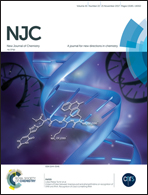Clinoptilolite nanoparticles modified with dimethyl glyoxime as a sensitive modifier for a carbon paste electrode in the voltammetric determination of Ni(ii): experimental design by response surface methodology†
Abstract
Clinoptilolite nanoparticles (Cn) were modified with dimethyl glyoxime (DMG) and the resulting Cn-DMG was used to construct a sensitive modified carbon paste electrode (CPE) for the voltammetric determination of Ni(II) in aqueous media. XRD, FT-IR, SEM, BET, TG-DTG and energy dispersive analysis X-ray spectroscopy (EDX) techniques were applied for the characterization of the raw and the modified samples. The experiments were designed using response surface methodology (RSM) to study the interaction effects of experimental variables on the voltammetric response of the modified electrode. The maximum peak current (response variable) was achieved for the run with pH 5.5, 0.2 mol L−1 KCl and a potential scan rate of 116 mV s−1, using 19.5% of the Cn-DMG modifier (prepared in 0.1 mol L−1 DMG solution). Quantitative determination of Ni(II) by the modified electrode in square wave voltammetry showed a linear response between the peak current and Ni(II) concentration in the range of 10.0 to 41.0 μmol L−1 Ni(II) with a detection limit of 7 μmol L−1 Ni(II).



 Please wait while we load your content...
Please wait while we load your content...